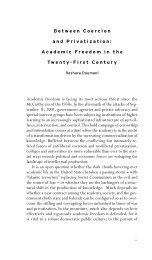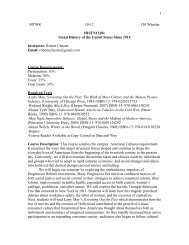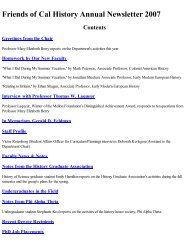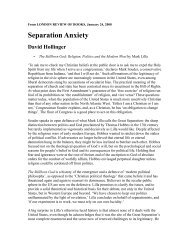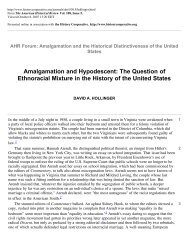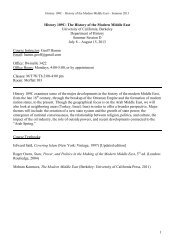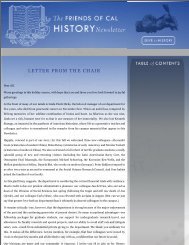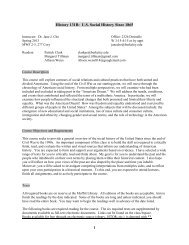Modern Art and Oral History in the United States: A Revolution ...
Modern Art and Oral History in the United States: A Revolution ...
Modern Art and Oral History in the United States: A Revolution ...
- No tags were found...
Create successful ePaper yourself
Turn your PDF publications into a flip-book with our unique Google optimized e-Paper software.
<strong>Modern</strong> <strong>Art</strong> <strong>and</strong> <strong>Oral</strong> <strong>History</strong> <strong>in</strong> <strong>the</strong> <strong>United</strong> <strong>States</strong>: A <strong>Revolution</strong> RememberedAuthor(s): Richard C<strong>and</strong>ida SmithSource: The Journal of American <strong>History</strong>, Vol. 78, No. 2 (Sep., 1991), pp. 598-606Published by: Organization of American HistoriansStable URL: http://www.jstor.org/stable/2079537 .Accessed: 22/01/2011 19:24Your use of <strong>the</strong> JSTOR archive <strong>in</strong>dicates your acceptance of JSTOR's Terms <strong>and</strong> Conditions of Use, available at .http://www.jstor.org/page/<strong>in</strong>fo/about/policies/terms.jsp. JSTOR's Terms <strong>and</strong> Conditions of Use provides, <strong>in</strong> part, that unlessyou have obta<strong>in</strong>ed prior permission, you may not download an entire issue of a journal or multiple copies of articles, <strong>and</strong> youmay use content <strong>in</strong> <strong>the</strong> JSTOR archive only for your personal, non-commercial use.Please contact <strong>the</strong> publisher regard<strong>in</strong>g any fur<strong>the</strong>r use of this work. Publisher contact <strong>in</strong>formation may be obta<strong>in</strong>ed at .http://www.jstor.org/action/showPublisher?publisherCode=oah. .Each copy of any part of a JSTOR transmission must conta<strong>in</strong> <strong>the</strong> same copyright notice that appears on <strong>the</strong> screen or pr<strong>in</strong>tedpage of such transmission.JSTOR is a not-for-profit service that helps scholars, researchers, <strong>and</strong> students discover, use, <strong>and</strong> build upon a wide range ofcontent <strong>in</strong> a trusted digital archive. We use <strong>in</strong>formation technology <strong>and</strong> tools to <strong>in</strong>crease productivity <strong>and</strong> facilitate new formsof scholarship. For more <strong>in</strong>formation about JSTOR, please contact support@jstor.org.Organization of American Historians is collaborat<strong>in</strong>g with JSTOR to digitize, preserve <strong>and</strong> extend access toThe Journal of American <strong>History</strong>.http://www.jstor.org
<strong>Modern</strong> <strong>Art</strong> <strong>and</strong> <strong>Oral</strong> <strong>History</strong><strong>in</strong> <strong>the</strong> <strong>United</strong> <strong>States</strong>:A <strong>Revolution</strong> RememberedRichard C<strong>and</strong>ida SmithIn 1943 art dealer Paul Rosenberg learned <strong>the</strong> distress<strong>in</strong>g news that a major collectionof modern art, <strong>in</strong>clud<strong>in</strong>g works by pa<strong>in</strong>ters represented <strong>in</strong> his prestigious Manhattangallery, would be sold at auction, most likely at prices significantly below <strong>the</strong> valuesRosenberg had established. He was most concerned about <strong>the</strong> fate of <strong>the</strong> GeorgesBraque pa<strong>in</strong>t<strong>in</strong>gs because he had a sizable <strong>in</strong>vestmentBraque's work. He sacrificedseveral American modernist pa<strong>in</strong>t<strong>in</strong>gs at below-market prices to obta<strong>in</strong> quick cashfor purchas<strong>in</strong>g <strong>the</strong> Braque work before it went to <strong>the</strong> auction block. Max Weber,one of <strong>the</strong> American pa<strong>in</strong>ters whose prices were slashed, felt betrayed. "He didn'tlift a f<strong>in</strong>ger to protect me," Weber recalled, "<strong>and</strong> that was <strong>the</strong> word he used whenhe <strong>in</strong>vited me to jo<strong>in</strong> his gallery -he would be my protector." Weber broke withRosenberg <strong>in</strong> a well-publicized <strong>and</strong> acrimonious dispute. "French prices <strong>and</strong> prestigehad to be ma<strong>in</strong>ta<strong>in</strong>ed at any cost; consequently reduction of American prices was<strong>the</strong> more practical <strong>and</strong> profitable [course] for him." As long as American modernismwas <strong>in</strong>stitutionally connected to French art, he concluded, American pa<strong>in</strong>ters hadlittle likelihood of secur<strong>in</strong>g ei<strong>the</strong>r a public or respect.'In this same period, Mark Rothko <strong>and</strong> Clyfford Still began tell<strong>in</strong>g colleagues <strong>and</strong>students that American pa<strong>in</strong>ters had noth<strong>in</strong>g to learn from <strong>the</strong> European moderns.Clay Spohn, a student of Fern<strong>and</strong> LUger's <strong>in</strong> <strong>the</strong> 1920s, remembered that he wasshocked when he first heard <strong>the</strong>ir argument. Then, with a profound sense of release,he embraced it. He surveyed nearly twentyears of work, both as a muralist <strong>in</strong> <strong>the</strong>Federal <strong>Art</strong> Project <strong>and</strong> as an <strong>in</strong>dependent modernist, <strong>and</strong> concluded that his lessons<strong>in</strong> Paris had led him to strive for an idealized, elegant perfection at <strong>the</strong> cost of spon-Richard C<strong>in</strong>dida Smith is pr<strong>in</strong>cipal editor <strong>in</strong> <strong>the</strong> <strong>Oral</strong> <strong>History</strong> Program, University of California, Los Angeles,<strong>and</strong> executive secretary of <strong>the</strong> <strong>Oral</strong> <strong>History</strong> Association. He is currently engaged <strong>in</strong> a study of avant-garde movements<strong>in</strong> California from 1925 to 1970.I would like to thank Betty Blum, <strong>Art</strong> Institute of Chicago; Nancy Dean, Cornell University Manuscripts Library;Ronald Grele, <strong>Oral</strong> <strong>History</strong> Research Office, Columbia University; Maygene Daniels <strong>and</strong> Anne Ritchie, NationalGallery of <strong>Art</strong>; Robert F. Brown, Paul Karlstrom, Maggie Nelson, <strong>and</strong> Barbara Wilson, Archives of American <strong>Art</strong>,Smithsonian Institution; <strong>and</strong> Sharon Zane, Museum of <strong>Modern</strong> <strong>Art</strong>, for <strong>the</strong>ir time <strong>in</strong> provid<strong>in</strong>g me with <strong>in</strong>formationon <strong>the</strong>ir programs <strong>and</strong> <strong>in</strong>sights <strong>in</strong>to <strong>the</strong> practice of oral history <strong>and</strong> <strong>the</strong> arts. Special thanks to Teresa Barnett <strong>and</strong>Dale Treleven, <strong>Oral</strong> <strong>History</strong> Program, University of California, Los Angeles, for <strong>the</strong>ir advice.1"The Rem<strong>in</strong>iscences of Max Weber," <strong>in</strong>terview by Carol S. Gruber, 1958, transcript, pp. 471-74 (<strong>Oral</strong> <strong>History</strong>Research Office, Butler Library, Columbia University, New York).598 The Journal of American <strong>History</strong> September 1991
<strong>Oral</strong> <strong>History</strong> 599taneity. He found that his sketches were more compell<strong>in</strong>g <strong>and</strong> satisfy<strong>in</strong>g visual statementsthan <strong>the</strong> f<strong>in</strong>ished pieces. He came to value rawness <strong>and</strong> immediacy over aref<strong>in</strong>ed formal coherence. "The th<strong>in</strong>gs I want to pa<strong>in</strong>t," he decided, were "<strong>the</strong> th<strong>in</strong>gsthat I experience not with my eyes but with my whole be<strong>in</strong>g."2The triumph <strong>in</strong> <strong>the</strong> mid-1940s of what we now loosely call abstract expressionismwas <strong>the</strong> product of a generation of artists pa<strong>in</strong>fully confront<strong>in</strong>g <strong>the</strong>i relation to tradition.<strong>Art</strong>ists tore <strong>the</strong>mselves away from old loyalties <strong>and</strong> groped toward new waysof conceptualiz<strong>in</strong>g <strong>the</strong>ir work. The revolution <strong>in</strong> <strong>the</strong> American art world went wellbeyond shifts <strong>in</strong> aes<strong>the</strong>tic preferences. The triumph of abstract, experimental stylesco<strong>in</strong>cided with a phenomenal growth <strong>in</strong> material support for <strong>the</strong> visual arts. Sixtysevenpercent of all American museums <strong>and</strong> 93 percent of corporate collections werefounded after 1940. The number of galleries <strong>in</strong> New York City represent<strong>in</strong>g contemporaryart tripled between 1949 <strong>and</strong> 1977, <strong>and</strong> that growth was matched by an evenlarger <strong>in</strong>crease <strong>in</strong> <strong>the</strong> number of one-artist exhibitions. By <strong>the</strong> mid-1970s museumattendance surpassed admissions to athletic events, <strong>and</strong> <strong>in</strong> <strong>the</strong> 1980 census, over onemillion Americans identified <strong>the</strong>ir occupation as artist, a 67 percent <strong>in</strong>crease from<strong>the</strong> previous census.3The experience of <strong>the</strong>se profound but recent changes has been documented extensively<strong>in</strong> oral history <strong>in</strong>terviews conducted <strong>in</strong> all parts of <strong>the</strong> country. Exist<strong>in</strong>gcollections counter superficial impressions that contemporary art was a concern only<strong>in</strong> New York <strong>and</strong> a few major urban centers. <strong>Oral</strong> sources allow us to see that <strong>the</strong>transformation of <strong>the</strong> arts was a national process <strong>and</strong> that, <strong>in</strong>deed, <strong>the</strong> growth ofarts <strong>in</strong>stitutions was even more dramatic outside New York. In this essay I will reviewmajor collections relat<strong>in</strong>g to <strong>the</strong> visual arts <strong>and</strong> consider <strong>in</strong> more detail what oralsources have to say about <strong>the</strong> national dimensions of <strong>the</strong> postwarevolution <strong>in</strong> <strong>the</strong>arts. I will conclude with a discussion of <strong>the</strong> <strong>in</strong>teraction of aes<strong>the</strong>tic <strong>and</strong> <strong>in</strong>stitutionalfactors revealed <strong>in</strong> oral sources.Major <strong>Oral</strong> <strong>History</strong> Collections <strong>in</strong> <strong>the</strong> Visual <strong>Art</strong>sWith nearly three thous<strong>and</strong> oral history <strong>in</strong>terviewsits catalog, <strong>the</strong> Archives ofAmerican <strong>Art</strong>, a division of <strong>the</strong> Smithsonian Institution, has assembled <strong>the</strong> s<strong>in</strong>glelargest collection of <strong>in</strong>terviews related to <strong>the</strong> visual arts <strong>in</strong> <strong>the</strong> <strong>United</strong> <strong>States</strong>. Theearliest <strong>in</strong>terviews were conducted <strong>in</strong> <strong>the</strong> 1940s, but <strong>the</strong> archives began <strong>in</strong>terview<strong>in</strong>g<strong>in</strong> earnest <strong>in</strong> 1958 with a project to collect <strong>the</strong> memories of pioneers of Americanmodernism. In 1961 a national conference on oral history <strong>and</strong> <strong>the</strong> arts sponsoredby <strong>the</strong> archivesurveyed <strong>the</strong> needs <strong>and</strong> possibilities of susta<strong>in</strong>ed <strong>in</strong>terview-based re-2"Tape-Recorded Intervie with Clay Spohn at His Studio <strong>in</strong> Gr<strong>and</strong> Street, New York City," <strong>in</strong>terview by PaulCumm<strong>in</strong>gs, Jan. 9, Feb. 5, 1976, transcript, pp. 75-78, 83 (Archives of American <strong>Art</strong>, Smithsonian Institution,Wash<strong>in</strong>gton, D.C.).3 Statistics from Diana Crane, The Transformation of <strong>the</strong> Avant-Garde: The New York <strong>Art</strong> World, 1940-1985(Chicago, 1987), 4-6. For a discussion of <strong>the</strong> burgeon<strong>in</strong>g popularity of <strong>the</strong> visual arts, see Col<strong>in</strong> Eisler, "American<strong>Art</strong> <strong>History</strong>: God Shed His Grace on Thee, or <strong>the</strong> Good, <strong>the</strong> True, <strong>and</strong> <strong>the</strong> Beautiful through <strong>the</strong> Bicentennial,"<strong>Art</strong>news, 75 (May 1976), 64-73.
600 The Journal of American <strong>History</strong>September 1991search projects. An immediate result of <strong>the</strong> conference was a project that collectedmore than three hundred <strong>in</strong>terviews on New Deal federal arts programs. Later archivesundertak<strong>in</strong>gs, funded by grants from state arts councils, have exam<strong>in</strong>ed regionaldevelopments <strong>in</strong> American art. Recent projects have recorded <strong>the</strong> experiencesof women <strong>and</strong> nonwhite artists. The archives' most recent project focuses on artists<strong>in</strong> midcareer.4Strong regionally focused collections can be found at California State University,Long Beach; Claremont Graduate School; Columbia University; <strong>the</strong> Maryl<strong>and</strong> HistoricalSociety; <strong>the</strong> Berkeley <strong>and</strong> Los Angeles campuses of <strong>the</strong> University of California;<strong>and</strong> <strong>the</strong> University of Wash<strong>in</strong>gton.5 The largest compilation of <strong>in</strong>terviews withAfrican-American artists is at <strong>the</strong> Hatch-Billops Collection <strong>in</strong> New York City. TheChicago Historical Society <strong>and</strong> <strong>the</strong> Chicago office of <strong>the</strong> Archives of American <strong>Art</strong>,housed at <strong>and</strong> staffed by <strong>the</strong> <strong>Art</strong> Institute of Chicago, have focused on <strong>in</strong>terview<strong>in</strong>gChicago's black artists, with emphasis on <strong>the</strong> <strong>in</strong>fluential social realist school thatflourished <strong>in</strong> that city's black community <strong>in</strong> <strong>the</strong> 1930s <strong>and</strong> 1940s. The <strong>Oral</strong> <strong>History</strong>Program at <strong>the</strong> University of California, Los Angeles (UCLA), recently began a serieson African-American artists <strong>and</strong> gallery owners after not<strong>in</strong>g that <strong>the</strong> black contributionto California's culturalife was virtually ignored <strong>in</strong> <strong>the</strong> numerous <strong>and</strong> extensivecollections deal<strong>in</strong>g with <strong>the</strong> state's art. The sou<strong>the</strong>rn California office of <strong>the</strong> Archivesof American <strong>Art</strong> has ongo<strong>in</strong>g projects <strong>in</strong>terview<strong>in</strong>g Lat<strong>in</strong>o artists <strong>and</strong> key figures<strong>in</strong> <strong>the</strong> development of <strong>the</strong> women's art movement <strong>in</strong> <strong>the</strong> 1970s. Interviews at <strong>the</strong>Hubbell Trad<strong>in</strong>g Post, Ganado, Arizona, are probably <strong>the</strong> s<strong>in</strong>gle largest collection<strong>in</strong> <strong>the</strong> <strong>United</strong> <strong>States</strong> relat<strong>in</strong>g to native American arts. The Hubbell <strong>in</strong>terviews focuson Navaho weav<strong>in</strong>g <strong>and</strong> o<strong>the</strong>r crafts, <strong>the</strong> <strong>in</strong>fluences an exp<strong>and</strong><strong>in</strong>g market had ondesign <strong>and</strong> production techniques, <strong>and</strong> <strong>the</strong> <strong>in</strong>teraction of Navaho <strong>and</strong> European-American artists who have settled <strong>in</strong> Arizona.The National Gallery of <strong>Art</strong> <strong>and</strong> <strong>the</strong> Museum of <strong>Modern</strong> <strong>Art</strong> have begun oralhistory projects to documen <strong>the</strong>ir <strong>in</strong>stitutional histories.6 These efforts deepen <strong>the</strong>historical record by add<strong>in</strong>g <strong>in</strong>formation on debates <strong>and</strong> compromises beh<strong>in</strong>d decisions,often recorded only <strong>in</strong> <strong>the</strong> most perfunctory manner <strong>in</strong> board m<strong>in</strong>utes. Animportant goal of <strong>the</strong> National Gallery project is to open <strong>in</strong>stitutional policies to<strong>in</strong>ternal analysis by provid<strong>in</strong>g staff members with more detailed histories of <strong>the</strong> decisions<strong>and</strong> personalities that shaped <strong>the</strong>ir current responsibilities. Importantopics4For a partial list<strong>in</strong>g of <strong>in</strong>terviews, see The Card Catalog of <strong>the</strong> <strong>Oral</strong> <strong>History</strong> Collections of <strong>the</strong> Archives ofAmerican <strong>Art</strong> (Wilm<strong>in</strong>gton, 1984). For a discussion of oral history collections on <strong>the</strong> federal arts, writers, <strong>and</strong><strong>the</strong>ater projects, see Roy Rosenzweig <strong>and</strong> Barbara Melosh, "Government <strong>and</strong> <strong>the</strong> <strong>Art</strong>s: Voices from <strong>the</strong> New DealEra," Journal of American <strong>History</strong>, 77 (Sept. 1990), 596-608.5 For <strong>in</strong>formation <strong>and</strong> catalogs of collections, contact <strong>the</strong> <strong>Oral</strong> <strong>History</strong> Archives, California State University,Long Beach; <strong>the</strong> <strong>Oral</strong> <strong>History</strong> Program, Claremont Graduate School, Claremont, California; <strong>the</strong> <strong>Oral</strong> <strong>History</strong> ResearchOffice, Columbia University, New York; <strong>the</strong> Reference Division, Library, Maryl<strong>and</strong> Historical Society, Baltimore;<strong>the</strong> Regional <strong>Oral</strong> <strong>History</strong> Office, University of California, Berkeley; <strong>the</strong> <strong>Oral</strong> <strong>History</strong> Program, Universityof California, Los Angeles; <strong>and</strong> <strong>the</strong> Manuscripts Collection, University Libraries, University of Wash<strong>in</strong>gton, Seattle.This essay considers only archival oral history collections, but published <strong>in</strong>terviews are a ma<strong>in</strong>stay of art journalism.6 The National Gallery also houses a collection of <strong>in</strong>terviews perta<strong>in</strong><strong>in</strong>g to <strong>the</strong> Index of American Desigr. TheRussell Lynes Collection <strong>in</strong> <strong>the</strong> Archives of American <strong>Art</strong>, Smithsonian Institution, conta<strong>in</strong>s thirty-two <strong>in</strong>terviewsconducted by Lynes for Russell Lynes, Good Old <strong>Modern</strong>: An Intimate Portrait of <strong>the</strong> Museum of <strong>Modern</strong> <strong>Art</strong>(New York, 1973).
<strong>Oral</strong> <strong>History</strong> 601for museum-related <strong>in</strong>terviews <strong>in</strong>clude <strong>the</strong> <strong>in</strong>fluence collectors have had on museumpolicies, as well as <strong>the</strong> changes brought about by <strong>the</strong> <strong>in</strong>creas<strong>in</strong>g professionalizationof museum practice. In 1940 very few curators had advanced degrees; by 1990 anM.A., if not a Ph.D., had become a prerequisite for employment. Museum historiescan reveal how curators asserted <strong>the</strong>ir rights to shape exhibitions around <strong>the</strong>ir personalcritical perspectives. In related series, <strong>the</strong> Getty <strong>Art</strong> <strong>History</strong> Information Programhas used oral history to exam<strong>in</strong>e <strong>the</strong> work<strong>in</strong>g methodology of art historians,while <strong>the</strong> Getty Center for <strong>the</strong> <strong>History</strong> of <strong>Art</strong> <strong>and</strong> <strong>the</strong> Humanities <strong>and</strong> <strong>the</strong> UCLA<strong>Oral</strong> <strong>History</strong> Program have <strong>in</strong>itiated a jo<strong>in</strong>t project <strong>in</strong>vestigat<strong>in</strong>g <strong>the</strong> developmentof consensual st<strong>and</strong>ards <strong>in</strong> education, research, exhibition, <strong>and</strong> publication <strong>in</strong> <strong>the</strong>art historical field.7 Interaction of artist <strong>and</strong> curator is also a focus <strong>in</strong> <strong>the</strong> collectionof <strong>in</strong>terviews on <strong>the</strong> development of photography as a f<strong>in</strong>e art at <strong>the</strong> Center forCreative Photography at <strong>the</strong> University of Arizona.<strong>Oral</strong> Sources as Evidence<strong>Oral</strong> history collections have thrown a wide net across <strong>the</strong> field of practice. Not onlyartists but also those <strong>in</strong>volved <strong>in</strong> collect<strong>in</strong>g, <strong>in</strong>terpret<strong>in</strong>g, sell<strong>in</strong>g, <strong>and</strong> promot<strong>in</strong>gart have been <strong>in</strong>terviewed. Follow<strong>in</strong>g more general social <strong>in</strong>terest <strong>in</strong> gender <strong>and</strong>multicultural issues, oral historians have collected <strong>in</strong>terviews with women <strong>and</strong> nonwhiteartists. <strong>Oral</strong> history <strong>in</strong> <strong>the</strong> arts, from its early days <strong>in</strong> <strong>the</strong> 1940s, has beenconcerned with exp<strong>and</strong><strong>in</strong>g <strong>the</strong> def<strong>in</strong>ition of what is significant. The regional <strong>and</strong>local orientation of most oral history projects promoted efforts to show, <strong>in</strong> <strong>the</strong> wordsof one <strong>in</strong>terviewer, that while her community might not have witnessed anyth<strong>in</strong>gas excit<strong>in</strong>g as <strong>the</strong> birth of impressionism, it was never mired <strong>in</strong> <strong>the</strong> Dark Ages ei<strong>the</strong>r.8As a result, a substantial majority of oral history <strong>in</strong>terviews<strong>the</strong> visual arts havebeen with artists, critics, <strong>and</strong> exhibitors outside New York City. Even <strong>the</strong> Archivesof American <strong>Art</strong> has taped approximately two-thirds of its <strong>in</strong>terviews with figuresfrom outside <strong>the</strong> New York area. The picture of modern art found <strong>in</strong> <strong>in</strong>terviewsis considerably different from that presented <strong>in</strong> most surveys of twentieth-centuryAmerican art. Few <strong>in</strong>terviewees atta<strong>in</strong>ed <strong>in</strong>ternational prom<strong>in</strong>ence, but <strong>the</strong>y hadfull careers as practic<strong>in</strong>g artists <strong>and</strong> teachers. <strong>Oral</strong> history collections give a senseof <strong>the</strong> variety of experience <strong>and</strong> <strong>the</strong> attitudes prevalent among <strong>the</strong> rank <strong>and</strong> fileof professional artists at various times <strong>in</strong> this century.Not surpris<strong>in</strong>gly, regionally based artists are obsessed with <strong>the</strong> New York art scene,<strong>the</strong> center where success is ultimately determ<strong>in</strong>ed. The choice not to be at <strong>the</strong> centerhas to be expla<strong>in</strong>ed <strong>and</strong> shown not to be prima facie evidence of failure. Lorser Feitelson,who relocated to Los Angeles <strong>in</strong> 1927 after hav<strong>in</strong>g lived <strong>in</strong> New York <strong>and</strong> Paris,suggested <strong>in</strong> a 1964 <strong>in</strong>terview how artists must negotiate <strong>the</strong>ir relationship to NewYork. He recalled that he disliked his new home "violently <strong>in</strong> <strong>the</strong> beg<strong>in</strong>n<strong>in</strong>g, because7Complete transcripts for most of <strong>the</strong> <strong>in</strong>terviews conducted for Marilyn Schmitt, ed., Object, Image, Inquiry:The <strong>Art</strong> Historian at Work (Santa Monica, 1988) are available at <strong>the</strong> Department of Special Collections, <strong>the</strong> GettyCenter for <strong>the</strong> <strong>History</strong> of <strong>Art</strong> <strong>and</strong> <strong>the</strong> Humanities, Santa Monica, California.8 Betty Blum of <strong>the</strong> <strong>Art</strong> Institute of Chicago discussed this with me <strong>in</strong> a telephone conversation, November 1990.
602 The Journal of American <strong>History</strong>September 1991<strong>the</strong>re was no art appreciation." With<strong>in</strong> six months, he found himself happy to be<strong>in</strong> Californiabecause <strong>the</strong>re wasn't any art appreciation <strong>the</strong>reforeartist had to pa<strong>in</strong>t for onlyone person, himself. There was no one to write about his art; no one ever to showhis art; no one ever to buy his art; <strong>the</strong>refore if he wanted to pa<strong>in</strong>t it was only becausehe himselfelt it must be done. And <strong>the</strong>reforewas go<strong>in</strong>g to pa<strong>in</strong>t for its ownsake <strong>and</strong> <strong>the</strong>n he would do honest work. That's what I liked about it.9Yet Feitelson's <strong>in</strong>terview also details <strong>the</strong> years he spent fight<strong>in</strong>g to build a publicfor modern art <strong>and</strong> to <strong>in</strong>tegrate <strong>the</strong> West Coast <strong>in</strong>to <strong>the</strong> <strong>in</strong>ternational art community.It was not so much isolation he wanted as a chance to participate, effected by exp<strong>and</strong><strong>in</strong>g<strong>the</strong> boundaries of <strong>the</strong> art world.Max Weber expressed similar feel<strong>in</strong>gs about <strong>the</strong> prov<strong>in</strong>cial quality of New Yorkbefore World War II. The city had been <strong>the</strong> "North Pole <strong>in</strong> modern art," he noted,un<strong>in</strong>terestedlocal talent. In his case, <strong>the</strong> hegemoni center was Paris, <strong>and</strong> <strong>the</strong><strong>in</strong>terview bristles with <strong>in</strong>dignation at <strong>the</strong> monopoly European taste had achieved."Even third-rate foreign artists come here <strong>and</strong> are welcomed <strong>and</strong> shown preference,while native talent is allowed to struggle <strong>and</strong> shift for itself. It has become a nationalcustom of this young, wealthy country to neglect <strong>and</strong> starve its own artists."10 Certa<strong>in</strong>lyWeber's recollections exaggerated <strong>the</strong> isolation of American modernists <strong>in</strong>pre-World War II New York, while Feitelson's account of Los Angeles's cultural backwardnesswas more stereotypical than accurate. The motifs of isolation <strong>and</strong> backwardnesswere narrative strategies both men adopted to expla<strong>in</strong> relatively modestcommercial success while simultaneously sublat<strong>in</strong>g any h<strong>in</strong>t of failure <strong>in</strong> a sense offreedom to be <strong>in</strong>novative. Frequently <strong>the</strong> response to <strong>the</strong> dom<strong>in</strong>ance of New Yorktakes <strong>the</strong> form of assert<strong>in</strong>g a unique quality to <strong>the</strong> art of a region, but <strong>the</strong> celebrationof regional cultures, if too prom<strong>in</strong>ently a jo<strong>in</strong>t goal of <strong>in</strong>terviewer <strong>and</strong> <strong>in</strong>terviewee,can obscure consideration <strong>in</strong> <strong>in</strong>terviews of important national patterns that helpexpla<strong>in</strong> aspects of artistic developments s<strong>in</strong>ce 1940.11 When similar patterns of explanationappear <strong>in</strong> <strong>in</strong>terviews from California, Ill<strong>in</strong>ois, Texas, Massachusetts, <strong>and</strong> NewYork, <strong>the</strong> ensemble suggests that particularist traditions have been part of a largernational pattern <strong>in</strong>volv<strong>in</strong>g <strong>the</strong> <strong>in</strong>tegration <strong>and</strong> articulation of an art <strong>in</strong>frastructurestretch<strong>in</strong>g across <strong>the</strong> country.Primary to <strong>the</strong> expansion of <strong>the</strong> arts, but little understood by <strong>in</strong>dividuals with<strong>in</strong><strong>the</strong> profession, were government <strong>in</strong>itiatives, both federal <strong>and</strong> state, that providedstable <strong>in</strong>comes to artists with<strong>in</strong> <strong>the</strong> context of <strong>the</strong> expansion of higher education<strong>in</strong> <strong>the</strong> postwar years.12 <strong>Oral</strong> testimony reveals <strong>the</strong> central role of <strong>the</strong> "national de-9 "Tape-Recorded Intervie with Mr. Lorser Feitelson, May 12, 1964," <strong>in</strong>terview by Betty Lochrie Hoag, transcript,p. 11 (Archives of American <strong>Art</strong>).10 "Rem<strong>in</strong>iscences of Max Weber," 77, 330.11 For a discussion of <strong>the</strong> relationship of regional markets to New York, see Crane, Transformation of <strong>the</strong> Avant-Garde, 130-36.12 For a historical review of direct government support for <strong>the</strong> arts <strong>in</strong> <strong>the</strong> <strong>United</strong> <strong>States</strong>, see Kev<strong>in</strong> V. Mulcahy,"Government <strong>and</strong> <strong>the</strong> <strong>Art</strong>s <strong>in</strong> <strong>the</strong> <strong>United</strong> <strong>States</strong>," <strong>in</strong> The Patron State: Government <strong>and</strong> <strong>the</strong> <strong>Art</strong>s <strong>in</strong> Europe, NorthAmerica, <strong>and</strong>japan, ed. Milton C. Cumm<strong>in</strong>gs, Jr., <strong>and</strong> Richard S. Katz (New York, 1987), 311-32.
604 The Journal of American <strong>History</strong> September 1991e_ ._.. .............._.-__._~~~~ ~~ ~~ ~ ~~~ ~ ~ ~~~~~~~~~~~~~~~~~~~~~~~~~~~~~~~~~~~~~~~~~~~~~~~~~~~~~~~~~~~.._~~~~~~~~~~~~~~~~~~~~~~~~~~~~_ ~~~~~~~~~~~~~~~~~~~~~~~~~~~~~~~~......A_~~~~~~~~~~~~~~~~~~~~~~~~~~~~~~_.. . . .. i.......| .....John Outterbridge <strong>in</strong> front of W<strong>in</strong>dow with Ball (mixed media, 1991),Pasadena, California, May 1991. Photograph by Ka<strong>the</strong>r<strong>in</strong>e P. Smith.Courtesy Ka<strong>the</strong>r<strong>in</strong>e P Smith.<strong>the</strong> arts. Interviews give tantaliz<strong>in</strong>g h<strong>in</strong>ts that <strong>the</strong> peer-review process has extendeditself <strong>in</strong>to exhibition <strong>and</strong> grant-mak<strong>in</strong>g fields, previously adm<strong>in</strong>istered through juries.Equally <strong>in</strong>terest<strong>in</strong>g to track would be how <strong>the</strong> emergence of an <strong>in</strong>dependentwomen's art was l<strong>in</strong>ked, not only ideologically but structurally, to <strong>the</strong> developmentof women'studies. Ano<strong>the</strong>r area for <strong>in</strong>vestigation would be how museums, <strong>in</strong>creas<strong>in</strong>glystaffed by university-credentialed curators, became noncommercial exhibitionforums particularly suited to <strong>the</strong> needs of school-based teachers.Even though <strong>the</strong> <strong>in</strong>fluence of public policy is clearly visible <strong>in</strong> oral histories, most<strong>in</strong>terviewees do not perceive that <strong>the</strong>ir lives have been fundamentally affected bya panoply of government programs, perhaps because <strong>the</strong> programs have become<strong>the</strong> ground of a "normal" life for many artists. African-American artists, who havebeen underrepresented <strong>in</strong> <strong>the</strong> classroom, have more clearly perceived <strong>and</strong> described<strong>the</strong> effects, both positive <strong>and</strong> negative, on <strong>the</strong>ir lives <strong>and</strong> <strong>the</strong>ir art, of governmentprograms not directly related to art. From <strong>the</strong> midsixties to <strong>the</strong> end of <strong>the</strong> seventies,
<strong>Oral</strong> <strong>History</strong> 605E~~~~~~~~~~.no. ...n ....t... .. ..... .... ......W<strong>in</strong>dow with Ball (detail). Photograph by Ka<strong>the</strong>r<strong>in</strong>e P. Smith.Courtesy Ka<strong>the</strong>r<strong>in</strong>e P Smith.Office of Equal Opportunity <strong>and</strong> Comprehensive Employment Tra<strong>in</strong><strong>in</strong>g Act fundswere vital to <strong>the</strong> birth of <strong>in</strong>dependent African-American arts <strong>in</strong>stitutions. John Outterbridge,a Los Angeles-based assemblage <strong>and</strong> environmental artist, recalled eightblack arts organizations function<strong>in</strong>g <strong>in</strong> Watts, California, dur<strong>in</strong>g those years. When<strong>the</strong> Reagan adm<strong>in</strong>istration decimated federal poverty programs, Watts's art groupsvanished; <strong>the</strong>y were only partially replaced by a more limited city-funded program.'7Interviews often reveal surpris<strong>in</strong>g connections, which would o<strong>the</strong>rwise be <strong>in</strong>visibleor purely speculative. When asked if <strong>the</strong>re was an African-American visual arts traditionthat had <strong>in</strong>fluenced his work, John Outterbridge began speak<strong>in</strong>g of his childhood<strong>in</strong> North Carol<strong>in</strong>a. Ra<strong>the</strong>r than focus<strong>in</strong>g on draw<strong>in</strong>gs or wood carv<strong>in</strong>gs, herecalled <strong>the</strong> women <strong>and</strong> children of his family mak<strong>in</strong>g soap. Images piled on top17 John Outterbridge <strong>in</strong>terview by Richard C<strong>in</strong>dida Smith, 1989-1990, transcript <strong>in</strong> process (<strong>Oral</strong> <strong>History</strong> Program,University of California, Los Angeles).
606 The Journal of American <strong>History</strong>September 1991of each o<strong>the</strong>r: big black cast-iron pots bubbl<strong>in</strong>g on <strong>the</strong> stove, gr<strong>and</strong>mo<strong>the</strong>rs teach<strong>in</strong>g<strong>the</strong> children to stir <strong>in</strong> one direction only so <strong>the</strong> soap would not weaken, refresh<strong>in</strong>gsmells that filled <strong>the</strong> house, translucent bars sliced <strong>and</strong> stacked to dry. "The wayit was stacked," Outterbridge remembered, "it used to look like build<strong>in</strong>gs, very beautifularchitectural forms - <strong>the</strong> way <strong>the</strong> light used to sh<strong>in</strong>e through <strong>the</strong>m." In describ<strong>in</strong>g<strong>the</strong>se images, he provided sources for visual <strong>the</strong>mes that reappear <strong>in</strong> his largelynonobjectivenvironments <strong>and</strong> assemblages. He also revealed his vision of <strong>the</strong> placeof art <strong>in</strong> African-American culture. His people did not produce "art," but lived <strong>the</strong>irdaily lives with an "expressive spirit." He fel this rema<strong>in</strong>ed after <strong>the</strong> migrationorth<strong>and</strong> west. He knew people <strong>in</strong> south central Los Angeles, where he works as directorof <strong>the</strong> Watts Towers <strong>Art</strong>s Center, who treated <strong>the</strong>ir front yards with an artist'sensibility.By that he did not mean merely elaborate l<strong>and</strong>scap<strong>in</strong>g or flowerbeds. He citedas an example a driveway with "<strong>the</strong> oldest Cadillac <strong>in</strong> <strong>the</strong> world stacked up on blocks<strong>and</strong> [<strong>the</strong> owner] wouldn't move it for anyth<strong>in</strong>g," had <strong>in</strong>deed surrounded <strong>the</strong> relicwith objects. "If I could take that front yard <strong>and</strong> transfer it to a gallery, it wouldbe a most successful work of art. We [African-American artists] can only mimic thatattitude. The person who relishes that yard, he's <strong>the</strong> artist. We're just react<strong>in</strong>g."18With <strong>the</strong> collapse of stable <strong>in</strong>stitutional support at <strong>the</strong> beg<strong>in</strong>n<strong>in</strong>g of <strong>the</strong> 1980s,<strong>the</strong> opportunities for African-American artists to explore <strong>and</strong> promote <strong>the</strong> visualramifications of <strong>the</strong>ir cultural tradition were sharply curtailed. In part, <strong>the</strong> debateover apply<strong>in</strong>g to <strong>the</strong> black aes<strong>the</strong>tic st<strong>and</strong>ards developed <strong>in</strong> "ma<strong>in</strong>stream" artschools, galleries, <strong>and</strong> museums reflects <strong>the</strong> differences between two k<strong>in</strong>ds of art<strong>in</strong>stitutions. Government policies <strong>in</strong> <strong>the</strong> 1960s <strong>and</strong> 1970s fostered <strong>the</strong> developmentof a network of "alternative" arts groups more rooted <strong>in</strong> local communities, committedto exp<strong>and</strong><strong>in</strong>g <strong>the</strong> boundaries of <strong>the</strong> art world by cont<strong>in</strong>u<strong>in</strong>g <strong>the</strong> process of open<strong>in</strong>gup participation. These groups were professional <strong>and</strong> committed to st<strong>and</strong>ardsof quality, but <strong>the</strong> roots of <strong>the</strong>ir aes<strong>the</strong>tic preferences were detached from <strong>the</strong> ethosof self-reflexive autonomy prevalent <strong>in</strong> <strong>the</strong> <strong>in</strong>stitutions that emerged after 1940. Had<strong>the</strong> policies practice dur<strong>in</strong>g <strong>the</strong> War on Poverty been cont<strong>in</strong>ued, that "alternative"vision would have deepened with experience <strong>and</strong> <strong>the</strong> present contours of culturallife <strong>in</strong> <strong>the</strong> <strong>United</strong> <strong>States</strong> would be considerably different.Practices of art <strong>in</strong>stitutions<strong>the</strong> <strong>United</strong> <strong>States</strong> have been powerfully affectedby government policies (<strong>and</strong> cash, or lack of it), even policies ostensibly hav<strong>in</strong>g noth<strong>in</strong>gto do with art. A complex <strong>in</strong>teraction of bureaucratic practice, fund<strong>in</strong>g sources,employment patterns, <strong>in</strong>tellectual <strong>and</strong> aes<strong>the</strong>tic preferences, <strong>and</strong> <strong>in</strong>dividual talentled to particular patterns for <strong>the</strong> distribution of rewards. A study of ideology <strong>and</strong>cultur expressed <strong>in</strong> <strong>in</strong>terviews uncovers <strong>the</strong> various, sometimes contradictory, selfimagesthat artists might adopt at given times <strong>and</strong> places dur<strong>in</strong>g this century. Beyondbiographical <strong>and</strong> sociological details, <strong>in</strong>terviews provide clues to how creative practicemediatesubjectivity, formal requirements, <strong>and</strong> collective dispositions. <strong>Oral</strong> history<strong>in</strong> <strong>the</strong> f<strong>in</strong>e arts can help unravel <strong>the</strong> ways aes<strong>the</strong>tichoices, shaped by personal<strong>and</strong> <strong>in</strong>stitutional self-images, <strong>in</strong>teracted with o<strong>the</strong>r aspects of society to create ourcultural <strong>in</strong>heritance.18 Ibid



